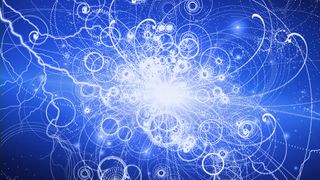Quarks are among the most fundamental constituents of matter, functioning as the building blocks of protons and neutrons, and, consequently, of atomic nuclei. This minuscule realm of the subatomic world can be likened to an intricate tapestry, where each thread weaves together to create the foundation of all visible matter. Understanding quarks involves delving into a complex yet captivating domain of particle physics, requiring an appreciation for both their nature and the environments in which they exist.
Quarks come in six varieties, commonly referred to as “flavors”: up, down, charm, strange, top, and bottom. Analogous to the spectrum of colors in a painter’s palette, each quark flavor exhibits distinctive properties and combinations, leading to the formation of various particles. The up and down quarks, for instance, are the most prevalent within the universe, combining to form protons and neutrons. Protons, composed of two up quarks and one down quark, exhibit a positive charge, while neutrons, formed from one up quark and two down quarks, remain electrically neutral. This triadic arrangement showcases the interplay between quarks and electromagnetic forces, which governs the behavior and interaction of subatomic particles.
Moving beyond mere numbers, it is imperative to contemplate the dimensions of quarks. These elementary particles are enveloped within a significantly larger framework governed by the theory of quantum chromodynamics (QCD). Much like a conductor leading an orchestra, QCD elucidates how quarks interact via the strong force, mediated by particles known as gluons. Gluons serve as the ‘glue’ that binds quarks together inside protons and neutrons, transcending the traditional notions of force; unlike gravity or electromagnetism, the strong force is both attractive and repulsive, depending on the color charge of the quarks involved.
The concept of color charge, while metaphorical, can be understood as a property that quarks possess, enabling them to interact with gluons. It should be noted that “color” in this context has no association with visual perception. Rather, there are three types of color charge identified: red, green, and blue. Just as a color wheel demonstrates the harmonious blend of hues, quarks must form combinations that neutralize their color charge. A stable particle, such as a proton or neutron, ultimately manifests a color-neutral state known as “color confinement,” where quarks remain bound within their particle, much like beads tightly strung on a thread.
Despite their elusive nature, quarks are not easily isolated in the universe; they constitute the interior of composite particles known as hadrons. Hadrons are primarily categorized into two families: baryons and mesons. Baryons, including protons and neutrons, encapsulate three quarks, while mesons consist of a quark and an antiquark pair. The creation and annihilation of quark-antiquark pairs in the shining crucible of high-energy environments, such as particle accelerators, evoke the vibrant imagery of a cosmic forge, where matter and antimatter collide, giving rise to an ephemeral ballet of quark interactions.
Notably, quarks are impervious to detection in isolation due to a phenomenon known as confinement; they perpetually remain bound within larger particles. When attempts are made to separate quarks from hadrons under high-energy conditions, the energy applied transcends the energy-mass equivalence, leading to the production of new quark-antiquark pairs instead of isolated quarks setting foot into the observable realm. This resemblance to a dramatic moment in a theatrical performance, where the curtain rises but the actor remains concealed, metaphorically conveys the challenges physicists face in discerning these fundamental entities independently.
Exploring the environments where quarks reside necessitates investigating the extreme conditions under which their interactions can be discerned. One such venue is the core of neutron stars, where the densities are so immense that protons and neutrons undergo an exotic transformation into a quark-gluon plasma. This state of matter, believed to have existed just microseconds after the Big Bang, offers insights into the primordial universe, making it a tantalizing subject for theoretical investigations. Within this plasma, quarks and gluons roam freely, unconfined by their particle counterparts, painting a vivid portrait of the early stages of cosmic evolution.
Research continues to unveil the intricacies of quarks through experiments at CERN’s Large Hadron Collider (LHC) and other particle accelerators, where particles are collided at near-light speeds. These experiments epitomize humanity’s quest for understanding the fundamental components of existence. Although quarks may seem diminutive and transient, they embody profound implications for the structure of matter and the fabric of the universe itself.
In summation, quarks are not mere abstract phenomena confined to theoretical discussions; they are vital players in the cosmic narrative, providing the underpinning for matter as we know it. Their unique features and interactions with gluons illuminate the forces that govern the universe, illustrating a cosmic dance of stability and transformation. As physicists delve deeper into the subatomic landscape, the allure of quarks continues to evoke wonder, highlighting the notion that even the tiniest particles can produce the grandest marvels. The quest to comprehend these building blocks mirrors the journey of humanity itself: a perpetual exploration of the unknown, navigating through colorful threads of reality while weaving a tapestry of knowledge that ultimately unveils the wonders of the universe.












